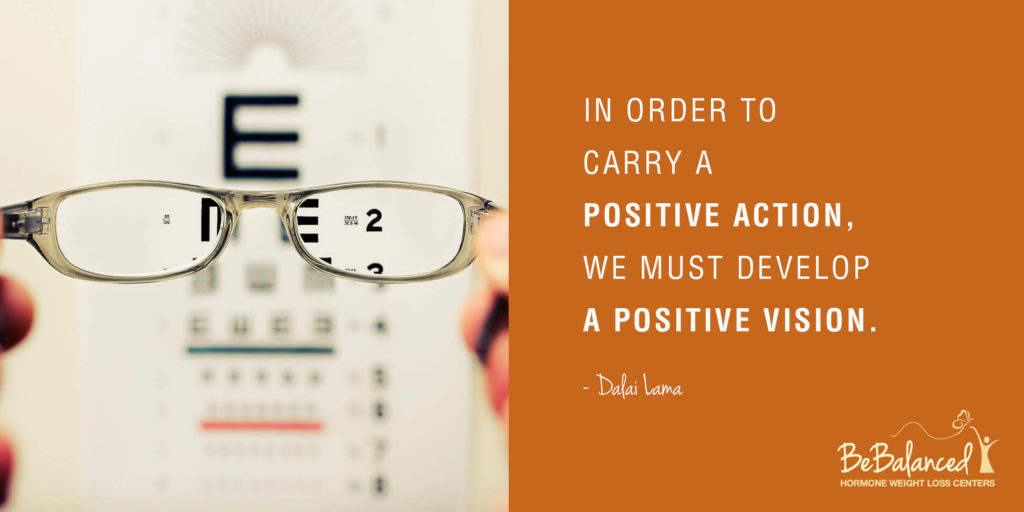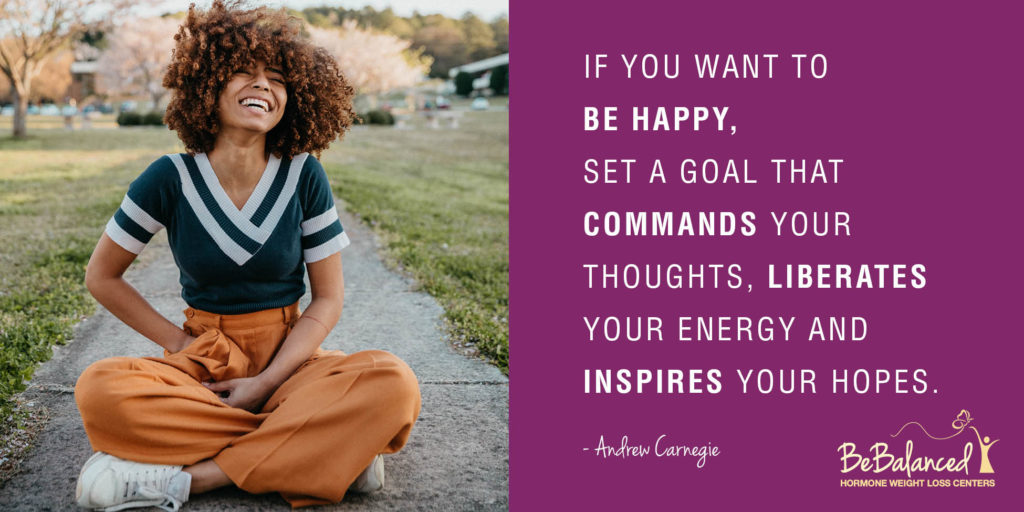
“If you want meaningful, lasting change in your life, you need a plan with a purpose.” – BeBalanced
In theory, New Year’s resolutions sound wonderful: On January 1st, you pledge to make a change. Then, your life changes for the better. But it’s not that simple. Why? Because goals you’ve set for yourself are difficult to maintain without proper preparation. Before we dive into what does work, in creating positive change, let’s talk about what doesn’t.
Why resolutions fail.
Resolutions tend to be back or white, all or nothing. And we don’t usually plan out how to sustain those resolutions for a whole year. Perhaps that’s why only 8 percent of people who make a New Year’s resolution keep it.
As a result, we feel bad about ourselves, believing we don’t have the willpower, self-discipline, or motivation to stick to our goals. Our self-esteem takes a hit, making us less likely to try again or throw in the towel completely.
Here are 3 of the top reasons why resolutions fail:
- They are too big or unattainable.
- They are not specific enough and have no action steps.
- They are based on what we think we should do, or what someone else wants, and not what we truly want.
If you want meaningful, lasting change in your life, you need a plan with a purpose.
Study after study has shown, the best way to reach a goal is to have a clear plan with attainable action items. These action items, when performed consistently over time, begin to form habits. Habits are what streamline and simplify our lives. When actions develop into habits, they become automatic, requiring less mental and emotional energy to complete the action.
Without a doubt, habits work. But without a motivating factor, or an inner ‘why’ you want to do these actions, they are not likely to stick and form new habits.
If you follow the steps in this Resolution Free Guide to Reaching Your Goals, you will have a solid plan to create meaningful, lasting change in your life that is driven by purpose.
Now, let’s get started!
Want to follow along with the steps outlined below to write your own goal plan?
Step 1 – Assess the Previous Year (even if you’d like to erase it from your memory bank)
Before you set goals and learn how to create habits to achieve them, it’s important to assess the previous year… even if it was LESS than amazing.
Ask yourself these questions and write down your honest, heartfelt answers:
- What were my goals going into last year? Did I achieve any of them or make any progress?
- What went well and why? Or what do I have to be grateful for that happened?
- What could I have done better?
- How do I feel about last year? Do I feel fulfilled?
By answering these questions, you will have a clearer picture of the things in your life that are working, as well as the areas you may need to adjust and improve upon. Use this as a guide when sculpting your vision in step 2.
Step 2 – Create Your 1-year Vision

Create your vision. “In order to carry a positive action, we must develop a positive vision.” – Dalai Lama
Ok, the hardest part is over. Now, with a clean slate (and remember, every day is a clean slate), it’s time to create your vision for what you truly want and why you want it.
Your 1-year vision is a picture of your anticipated way of life or a mental picture of what you want. The more clearly you can hold that picture in your mind, the more likely you’ll be able to achieve it. When you visualize your outcome clearly, your brain becomes far more effective at manifesting it.
Imagine, for a moment that it’s one year from today. Think about your ideal day. Where are you living? Whom are you with? What are you doing for work and how much money are you making? What are you doing that brings you fulfillment? How are you investing in yourself? How are you shaping your space and time so that all of your best qualities emerge?
Now, write it down in paragraph form. MOST IMPORTANTLY, write it as if it has already happened. Use phrases such as, “I have… I am…”
Here is a sample vision to get you started:
“I wake up each morning feeling refreshed and excited to take on the day. I have a loving, healthy relationship with my partner and spend dedicated time each day with my children. My house is filled with beautiful plants that I have nurtured throughout the year. My business revenue has increased by 30% and I am the proud owner of the BMW I always wanted. I am comfortable and confident in my body and I make time daily to invest in my emotional, physical and spiritual health. I joined a book club and regularly attend Zumba classes at my local gym. I give consistent donations to an organization that helps empower young women in economically disadvantaged communities. I feel fulfilled in all areas of my life.”
Wow, yes girl! That’s the spirit! Once you write out your version of what you want for your life, it’s time to start making goals to help you get there.
Step 3 – Write down your Goals… all of them!

Write down your goals. “If you want to be happy, set a goal that commands your thoughts, liberates your energy, and inspires your hopes.” – Andrew Carnegie
Now that you have a clear vision for what your life will look like, it’s time to make a list of goals that will help bring your vision to life. Start by listing every possible goal you can think of that you would like to accomplish this year (or in the timeline of your choosing). Later, you will have to set some priorities to narrow down these goals. But for now, the sky’s the limit.
We find it’s helpful to set goals based on the various areas of your life that you want to work on or categories. The categories and questions below each are suggestions to get your gears moving. Feel free to change up to or add new ones.
Again, write your goals down and aim to keep your goals positive. Avoid negative goals, such as, “I want to stop doing ________.”
- Career – What projects do I want to accomplish? What skills do I want to improve on? Do I desire a promotion or to change positions? Do I want to start a new career path? If so, where do I want to work or what do I want my job to be?
- Financial – How much money do I want to make? How much money do I want to save? How will I invest my money? How do I want to pay down debt? What fun things would I like to buy?
- Relationships – What do I want romantically? Are there people in my life I want to spend more time with? How do I want to parent my children? What values do I want to instill in them? What activities do I want to incorporate for my family?
- Health – Do I want to exercise more or try new physical activities? How do I want my body to look? Do I need to develop a better sleep schedule? How do I want to eat? Do I want to drink more water? Do I need to find a coach/trainer/mentor to help me? How do I want to feel daily? What areas of my health do I want to improve?
- Emotional – How do I want to feel, emotionally? What things make me smile that I want to do more of? What do I want to add to my daily routine that calms my mind? Do I want to start journaling? Do I want to become more aware of my feelings and emotions? Do I need to seek help or guidance?
- Personal Development – What skills do I want to learn? What projects do I want to accomplish around the house? What activities do I want to get involved with? Do I want to implement a self-care routine? What or how many books would I like to read? Do I want to further my education level? Do I want to attend any seminars?
- Spiritual – What personal spiritual practices would I like to maintain or begin? How often do I want to pray or meditate? How often do I want to visit church, a meeting, a service, etc.?
- Contribution – How will I give back? What causes do I want to support? What difference can do I want to make in my community and world?
- Leisure – Where do I want to take my family on vacation this year? Do I want to implement a monthly girl’s night, or plan a weekend trip? What fun activities do I want to do or try?
Step 4 – Identify Your Main (3-5) Goals
Once you have a written list of all your goals, it’s time to narrow them down. The number of goals chosen will be different for each person, but we suggest somewhere between 3 and 5 main goals. For some of you, choosing just one this year might be enough, and that’s ok! If you are new to this, start slow. You can always choose more main goals at any time.
If there are items on your goal list that aren’t going to require a lot of time and action steps to accomplish, great! Those will be included too. But for now, let’s focus on your main goals first.
The objective is to choose goals that are most likely to bring the greatest results or that get you closer to your vision. Consider choosing goals that speak to the biggest pain points or stressors in your life that you would like to change.
Another idea is to go through your list and rack each goal from 1-10, based on their importance to you, or how much accomplishing them would increase your feelings of happiness and fulfillment.
Before we move on to the next step in this guide, there is one last thing you need to do… and it’s just, if not MORE important, than identifying your main goals.
Step 4b – Sculpt your ‘Why’s’ (the secret sauce)!

Identify the ‘why’ of your goals. “An internal ‘why’ keep your motivational fire going.” – BeBalanced
Besides each of your main goals, write a statement about why you want to achieve each goal. Dig deep. Keep going until it gets personal. Be as real and vulnerable with yourself as you can. This is when your ‘why’ will help bring these goals to life and give them purpose. The internal ‘why’ keeps that motivational fire going.
Here is one example to get you started:
Major Goal #1 – Become a healthier version of myself.
Why: My weight and health issues keep me on the sidelines of life, unable to be the mom, wife, and friend I deeply desire to be. I deserve and choose to love myself in a way that honors my body both inside and out.
Now that you know your main goals and why you desire to achieve them, let’s set up some action items to keep this momentum going.
Step 5 – Define Action Items

Define actions to help achieve your goals. “A goal without a plan is just a wish.” Antoine de Saint-Exuprey
Under each of your main goals, your next task will be to determine what action steps need to be taken to help you achieve your goal. These action steps can be both measurable and non-mensurable. The number of action items is up to you, but a good starting place is about 3-5. If you find you are doing well at completing these actions, (eventually forming habits), you can always add more!
Going off the example goal listed above, here are a few action items that could go along with it:
Major Goal #1 – Become a healthier version of myself.
- Drink ½ my body weight in ounces every day.
- Walk for 20 minutes a day, 3x’s a week.
- Practice yoga or meditation for 10 minutes every day.
- Cut out processed foods and replace them with more natural alternatives.
- Read 3 pages of a book before bedtime every weekday.
Step 6 – Choose Your Minor Goals
Not every goal you wrote down on your master list is going to make the “Major List,” and that’s ok! You can still choose items beyond your main goals that you would like to have happened this year. These minor goals could be things like buying a new couch, taking a vacation, reading two books this year, trying a dance class, or planting a garden in the spring.
And just like your major goals, your minor goals can also include action steps as well.
Let’s choose taking a vacation, for example. The action items here might be something like this:
Minor Goal #1 – Take a family vacation.
- Set aside $____ from my paycheck each week until I reach $____.
- Contact a travel agent by _____ date.
- Schedule the vacation _____ weeks/months in advance.
- Tie up loose ends at work by _____ date to ensure I can focus my attention on my family during our vacation.
Generally speaking, your minor goals are the fun things you’d like to have, do, or try this year. And although they may not require as much focused effort to achieve them, creating action steps will help make planning for them or doing them more enjoyable and less stressful.
Lastly, not everything on your master goal list is going to make it to the main or minor list for this year. So, it’s a great idea to save your yearly goal list for when it’s time to reevaluate your goals for the following year.
Step 7– Building habits
How about building those habits we talked about? Yep, throw those on your list too!
In this portion, you can include additional habits that you want to practice. These are activities that don’t have a specific end date, but that when repeated over time, help supports your main goals, or just help you like a more fulfilled life in general.
When selecting daily habits, you might choose “Get up at 6 a.m. on weekdays,” “Writing down something you are grateful for,” and “Make the bed.” Weekly habits could include things like “Call a friend,” “Go for a bike ride,” and “Family dinner around the table Sundays.”
Step 8 – VISUALIZE!

Visual your goals. “The clearer you are when visualizing your dreams, the brighter the spotlight will be to lead you on the right path.” – Gail Lynne Goodwin
Now that you have your main and minor goals, as well as your habits plotted out on paper, print it out and hang it somewhere you will see it every day. Hang it in your office. Post it beside your bathroom mirror. Visualizing your goals and seeing them daily will help keep you on track.
Other helpful tips to keep your goals on track.
- Utilize a journal to monitor your goals and action items, as well as to set milestones, and track your daily and weekly habit lists.
- Tell someone! Now that you have set your goals with action steps, stay accountable by sharing your goals with a friend and asking them to check in on your progress.
- Schedule quarterly evaluation sessions with yourself to determine progress or to monitor areas where you need to regain focus.
- Set aside some time on Sunday evenings to recap on the week you just had and to regroup on your goals for the week.
- Be patient and give your efforts time to produce results. Rome wasn’t built in a day and neither are habits. Consistency over time is the key to successful change. And consistency doesn’t mean absolute perfection. If you miss a task or fall short in some area, just get right back on track as soon as possible! Small steps will eventually lead to big changes so don’t give up!
We hope this guide was helpful as you plan your goals any time during the year. For additional help reaching your health and wellness goals, we can help!
Schedule a free consultation, at one of our BeBalanced centers, to learn how you can lose weight quickly and naturally while improving your sleep, mood, energy, vitality, and overall wellbeing.
Be happy. Be healthy. Be you again.
– BeBalanced

